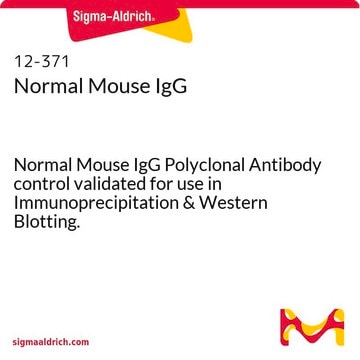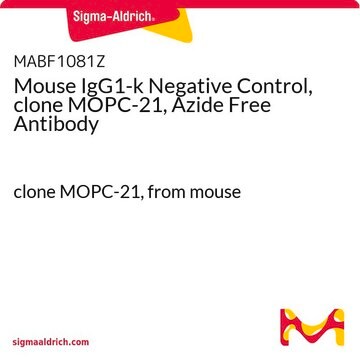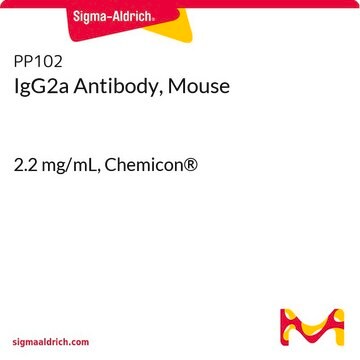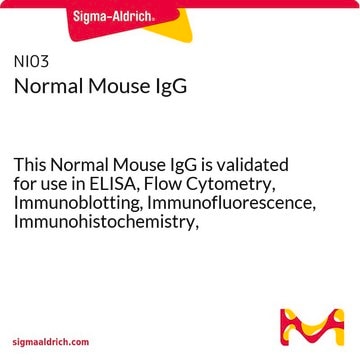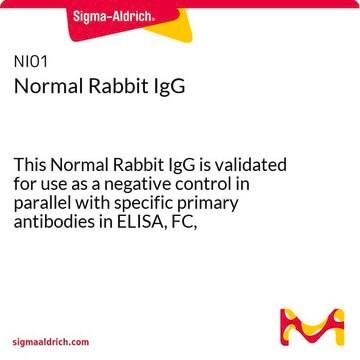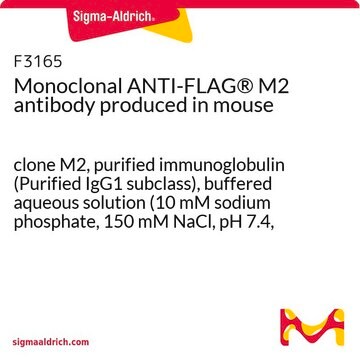MABC002
Mouse IgG1 Negative Control, clone Ci4
Mouse IgG1 Negative Control Monoclonal Antibody validated for use in Flow Cytometry & Immunofluorescence.
Iniciar sesiónpara Ver la Fijación de precios por contrato y de la organización
About This Item
Código UNSPSC:
12352203
eCl@ss:
32160702
NACRES:
NA.42
Productos recomendados
origen biológico
mouse
Nivel de calidad
forma del anticuerpo
purified immunoglobulin
clon
Ci4, monoclonal
fabricante / nombre comercial
Chemicon®
concentración
0.5 mg/mL
técnicas
flow cytometry: suitable
immunofluorescence: suitable
isotipo
IgG1
Condiciones de envío
wet ice
modificación del objetivo postraduccional
unmodified
Descripción general
Immunoglobulin G (IgG), is one of the most abundant proteins in human serum with normal levels between 8-17 mg/mL in adult blood. IgG is important for our defence against microorganisms and the molecules are produced by B lymphocytes as a part of our adaptive immune response. The IgG molecule has two separate functions; to bind to the pathogen that elicited the response and to recruit other cells and molecules to destroy the antigen. The variability of the IgG pool is generated by somatic recombination and the number of specificities in an individual at a given time point is estimated to be 1011 variants.
Especificidad
Reacts with chicken immunoglobulin. No reaction with human cell surface or plasma components has been observed. However some binding to Fc receptors may occur.
Inmunógeno
Chicken immunoglobulin
Aplicación
Mouse IgG1 Negative Control Monoclonal Antibody validated for use in Flow Cytometry & Immunofluorescence.
Mouse IgG1 is a monoclonal antibody intended for use as a negative control in immunofluorescence, flow cytometry, and immunoperoxidase staining on frozen and paraffin tissue sections. Its use enables an estimation of non-specific binding of mouse monoclonal antibodies to cell surface components in peripheral blood and tissue.
SUGGESTED USAGE
The control antibody should be diluted to the same concentration as the test antibody, and equivalent volumes used.
SUGGESTED USAGE
The control antibody should be diluted to the same concentration as the test antibody, and equivalent volumes used.
Research Category
Secondary & Control Antibodies
Epitope Tags & General Use
Secondary & Control Antibodies
Epitope Tags & General Use
Research Sub Category
Isotype Control Antibodies
Isotype Control Antibodies
Forma física
Format: Purified
Protein A Purified mouse immunoglobulin in phosphate buffered saline, pH 7.4, containing 0.2% bovine Serum albumin and 0.1% sodium azide.
Protein A purified
Almacenamiento y estabilidad
Maintain for 1 year at 2–8°C from date of shipment. For maximum recovery of product, centrifuge the original vial after thawing and prior to removing the cap.
Información legal
CHEMICON is a registered trademark of Merck KGaA, Darmstadt, Germany
Cláusula de descargo de responsabilidad
Unless otherwise stated in our catalog or other company documentation accompanying the product(s), our products are intended for research use only and are not to be used for any other purpose, which includes but is not limited to, unauthorized commercial uses, in vitro diagnostic uses, ex vivo or in vivo therapeutic uses or any type of consumption or application to humans or animals.
Código de clase de almacenamiento
12 - Non Combustible Liquids
Clase de riesgo para el agua (WGK)
WGK 2
Punto de inflamabilidad (°F)
Not applicable
Punto de inflamabilidad (°C)
Not applicable
Certificados de análisis (COA)
Busque Certificados de análisis (COA) introduciendo el número de lote del producto. Los números de lote se encuentran en la etiqueta del producto después de las palabras «Lot» o «Batch»
¿Ya tiene este producto?
Encuentre la documentación para los productos que ha comprado recientemente en la Biblioteca de documentos.
Los clientes también vieron
Sandra Rizzi et al.
Biochemistry and biophysics reports, 4, 291-298 (2015-10-09)
The sodium-activated potassium channels Slick (Slo2.1, KCNT2) and Slack (Slo2.2, KCNT1) are paralogous channels of the Slo family of high-conductance potassium channels. Slick and Slack channels are widely distributed in the mammalian CNS and they play a role in slow
E-cadherin and its downstream catenins are proteolytically cleaved in human HaCaT keratinocytes exposed to UVB.
Hung, Chi-Feng, et al.
Experimental Dermatology, 15, 315-321 (2006)
Lukas Amrell et al.
Cancer cell international, 24(1), 277-277 (2024-08-07)
Tucatinib (TUC), a HER2-directed tyrosine kinase inhibitor, is the first targeted drug demonstrating intracranial efficacy and significantly prolonged survival in metastatic HER2-positive breast cancer (BC) patients with brain metastases. Current treatments for brain metastases often include radiotherapy, but little is
Liku B Tezera et al.
eLife, 9 (2020-02-25)
Previously, we developed a 3-dimensional cell culture model of human tuberculosis (TB) and demonstrated its potential to interrogate the host-pathogen interaction (Tezera et al., 2017a). Here, we use the model to investigate mechanisms whereby immune checkpoint therapy for cancer paradoxically
Differential distribution of the sodium-activated potassium channels slick and slack in mouse brain.
Sandra Rizzi et al.
The Journal of comparative neurology, 524(10), 2093-2116 (2015-11-21)
The sodium-activated potassium channels Slick (Slo2.1, KCNT2) and Slack (Slo2.2, KCNT1) are high-conductance potassium channels of the Slo family. In neurons, Slick and Slack channels are involved in the generation of slow afterhyperpolarization, in the regulation of firing patterns, and
Nuestro equipo de científicos tiene experiencia en todas las áreas de investigación: Ciencias de la vida, Ciencia de los materiales, Síntesis química, Cromatografía, Analítica y muchas otras.
Póngase en contacto con el Servicio técnico



